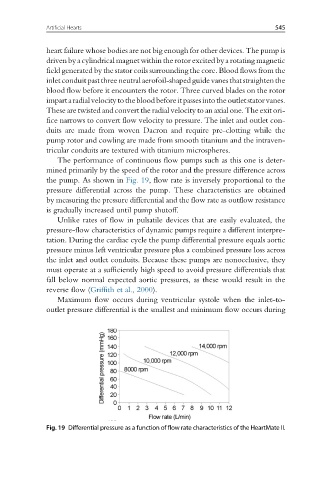Page 552 - Handbook of Biomechatronics
P. 552
Artificial Hearts 545
heart failure whose bodies are not big enough for other devices. The pump is
driven by a cylindrical magnet within the rotor excited by a rotating magnetic
field generated by the stator coils surrounding the core. Blood flows from the
inlet conduit past three neutral aerofoil-shaped guidevanes that straighten the
blood flow before it encounters the rotor. Three curved blades on the rotor
impartaradialvelocitytothebloodbeforeitpassesintotheoutletstatorvanes.
These are twisted and convert the radial velocity to an axial one. The exit ori-
fice narrows to convert flow velocity to pressure. The inlet and outlet con-
duits are made from woven Dacron and require pre-clotting while the
pump rotor and cowling are made from smooth titanium and the intraven-
tricular conduits are textured with titanium microspheres.
The performance of continuous flow pumps such as this one is deter-
mined primarily by the speed of the rotor and the pressure difference across
the pump. As shown in Fig. 19, flow rate is inversely proportional to the
pressure differential across the pump. These characteristics are obtained
by measuring the pressure differential and the flow rate as outflow resistance
is gradually increased until pump shutoff.
Unlike rates of flow in pulsatile devices that are easily evaluated, the
pressure-flow characteristics of dynamic pumps require a different interpre-
tation. During the cardiac cycle the pump differential pressure equals aortic
pressure minus left ventricular pressure plus a combined pressure loss across
the inlet and outlet conduits. Because these pumps are nonocclusive, they
must operate at a sufficiently high speed to avoid pressure differentials that
fall below normal expected aortic pressures, as these would result in the
reverse flow (Griffith et al., 2000).
Maximum flow occurs during ventricular systole when the inlet-to-
outlet pressure differential is the smallest and minimum flow occurs during
Fig. 19 Differential pressure as a function of flow rate characteristics of the HeartMate II.

